
Allium ‘Millenium’, Heuchera ‘Silver Gumdrop’, Schizachyrium ‘Blue Heaven’ in container outside PPA lecture hall
Each year, I attend the Perennial Plant Symposium. As a result, I have traveled the country, hearing lectures from the top people in the industry, visiting incredible gardens, and networking with people, old and new. The PPA family is one of the most sharing groups of which I’ve ever been a member. Even though I only see many of the members once a year, it’s like a family reunion – lots of hugs and kisses.
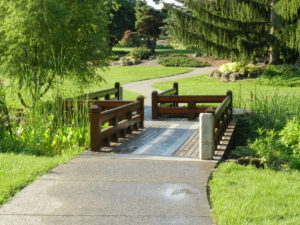
Interesting bridge configuration; Lyndale Park
Last week, we met in Minneapolis. Amazingly, it wasn’t any cooler there. In fact, our longest tour day, from 7:30 A.M. to 9:30 P.M. was in the nineties with very high humidity. But that didn’t keep us from admiring the gardens we saw, only that by the end of the day, we were walking a bit slower.

Raised bed (hügel) to prevent stormwater runoff
One of the gardens we visited sits on the edge of one of Minnesota’s 10,000 lakes and the owner is very concerned about preventing storm water runoff from entering the lake. She discovered a German concept called Hügelkultur (hill culture), a composting process employing raised planting beds constructed on top of decaying wood debris and other compostable plant materials. This method of constructing mounded beds or berms is also useful on sites where the soil is compacted. It is quite sustainable because it uses woody debris that is unsuitable for other uses, improves drainage, builds soil fertility, and helps retain moisture on site.
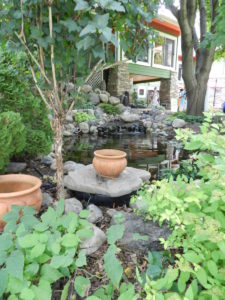
Pool into which water from downspout drains, stream above it, fountains above stream – prevents storm water runoff
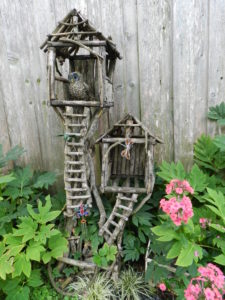
Bee houses
In one spot, a house downspout drains into a pool with a recirculating pump that sends the water back up a hill to three stone pillar fountains that then drain into a stream that ultimately drains into the pool. Bee houses are everywhere because the owner is very conscious of the need to help pollinators. This garden was relatively small.
The next garden was huge and maintained by a couple who are probably in their eighties. They started gardening on their lot but eventually purchased several others so we had lots to see.
The most amazing gardens we saw were a series of color rooms, with great attention paid to texture and form as well as color.
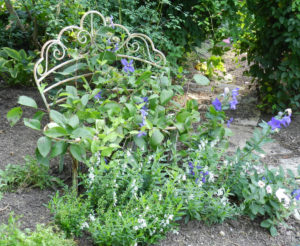
Clematis durandii on white wrought iron chair, Platycodon, white Angelonia
At another garden, the wife was a Clematis junkie, just like me, and the husband was a hosta and grass aficionado. He used a grouping of three Molinia caerulea ‘Moorhexe’ in the front yard as an excellent color contrast with the brick of the house. She had over 100 species and cultivars of Clematis. The one shown on the bench is a crawling species, not a twining species so it can also be used as a groundcover.
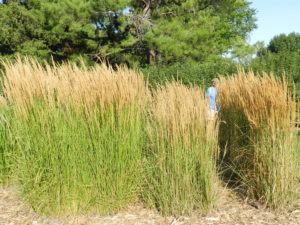
Three Calamagrostis cultivars side by side: ‘Avalanche’, ‘Overdam’, ‘Karl Foerster’
Our last stop on Wednesday was at the University of Minnesota Landscape Arboretum that has many specialty gardens. The most informative, for me, was the ornamental grass trial plots where Professor Mary Meyer has been testing grasses for thirty years. The opportunity to see cultivars of the same genus growing side by side while listening to Mary’s comments were invaluable.
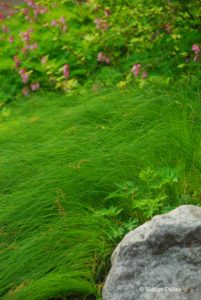
Carex pensylvanica used as lawn replacement; photo by Williiam Cullina
I also saw Carex pensylvanica growing well in both sun and shade. Why is this important? Because I have wrestled with how to create a grass-like “lawn” without turf. Many sedges thrive in the shade but not as many in the sun. This sedge can be mowed but doesn’t have to be. If mown, it only would be once every few months.
Next year, we’ll be Denver. Who knows what I’ll see and learn then that will inspire me anew.


0 Comments